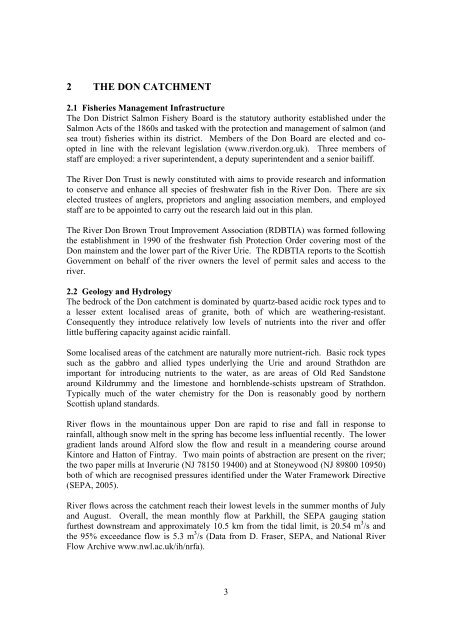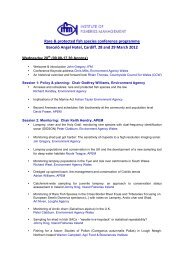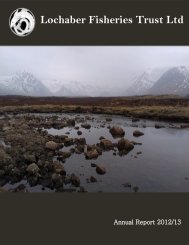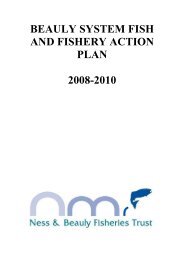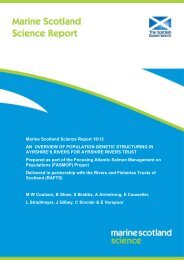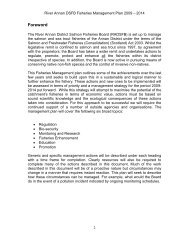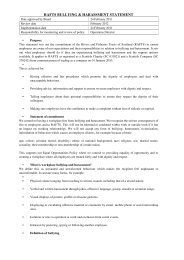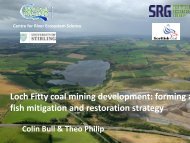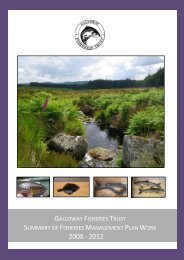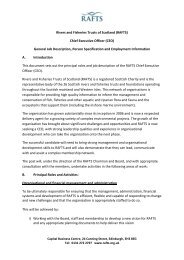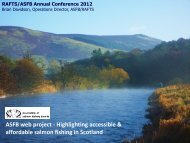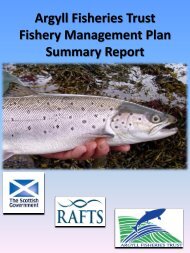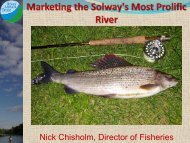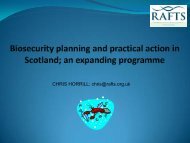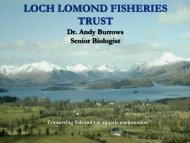You also want an ePaper? Increase the reach of your titles
YUMPU automatically turns print PDFs into web optimized ePapers that Google loves.
2 THE DON CATCHMENT2.1 Fisheries <strong>Management</strong> InfrastructureThe <strong>Don</strong> District Salmon <strong>Fishery</strong> Board is the statutory authority established under theSalmon Acts of the 1860s and tasked with the protection and management of salmon (andsea trout) fisheries within its district. Members of the <strong>Don</strong> Board are elected and cooptedin line with the relevant legislation (www.riverdon.org.uk). Three members ofstaff are employed: a river superintendent, a deputy superintendent and a senior bailiff.The River <strong>Don</strong> Trust is newly constituted with aims to provide research and informationto conserve and enhance all species of freshwater fish in the River <strong>Don</strong>. There are sixelected trustees of anglers, proprietors and angling association members, and employedstaff are to be appointed to carry out the research laid out in this plan.The River <strong>Don</strong> Brown Trout Improvement Association (RDBTIA) was formed followingthe establishment in 1990 of the freshwater fish Protection Order covering most of the<strong>Don</strong> mainstem and the lower part of the River Urie. The RDBTIA reports to the ScottishGovernment on behalf of the river owners the level of permit sales and access to theriver.2.2 Geology and HydrologyThe bedrock of the <strong>Don</strong> catchment is dominated by quartz-based acidic rock types and toa lesser extent localised areas of granite, both of which are weathering-resistant.Consequently they introduce relatively low levels of nutrients into the river and offerlittle buffering capacity against acidic rainfall.Some localised areas of the catchment are naturally more nutrient-rich. Basic rock typessuch as the gabbro and allied types underlying the Urie and around Strathdon areimportant for introducing nutrients to the water, as are areas of Old Red Sandstonearound Kildrummy and the limestone and hornblende-schists upstream of Strathdon.Typically much of the water chemistry for the <strong>Don</strong> is reasonably good by northernScottish upland standards.River flows in the mountainous upper <strong>Don</strong> are rapid to rise and fall in response torainfall, although snow melt in the spring has become less influential recently. The lowergradient lands around Alford slow the flow and result in a meandering course aroundKintore and Hatton of Fintray. Two main points of abstraction are present on the river;the two paper mills at Inverurie (NJ 78150 19400) and at Stoneywood (NJ 89800 10950)both of which are recognised pressures identified under the Water Framework Directive(SEPA, 2005).River flows across the catchment reach their lowest levels in the summer months of Julyand August. Overall, the mean monthly flow at Parkhill, the SEPA gauging stationfurthest downstream and approximately 10.5 km from the tidal limit, is 20.54 m 3 /s andthe 95% exceedance flow is 5.3 m 3 /s (Data from D. Fraser, SEPA, and National RiverFlow Archive www.nwl.ac.uk/ih/nrfa).3


